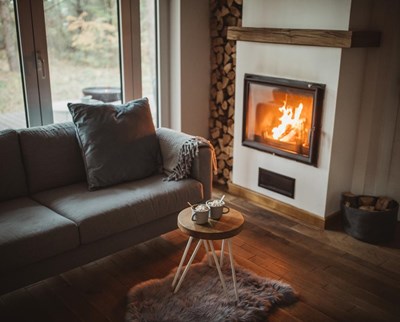
Brisk temperatures and snowstorms call for a cozy night sitting near the fireplace or woodstove. Although the warmth and smell of the fire is relaxing, you may not realize that the intake of wood smoke may not be good for you.
Over 27 million U.S. homes feature a fireplace, and many burn wood. According to the Contra Costa (Calif.) Health Services Department, up to 70 percent of the smoke from chimneys rebounds into nearby homes. The tiny particles in wood smoke are so small that even well-secured windows and doors can’t block their entrance. Even if you don’t have a fireplace in your home, indoor air quality may be poorly affected by fireplaces in your neighborhood.
What Air Pollutants are Emitted When Wood Burns?
Smoke forms when wood is burned, but the emission varies based on the intensity of the fire and where the fire is burning. According to the Environmental Protection Agency (EPA), when the wood isn’t burned completely the smoke it produces contains particulate matter along with carbon monoxide, benzene, formaldehyde, acrolein, polycyclic aromatic hydrocarbons, and other air pollutants.
Are there health effects from inhaling wood smoke?
Yes, there can be health effects from inhaling a significant amount wood smoke especially for sensitive individuals. These potential effects are due to the exposure of air pollutants in the smoke. According to the American Lung Association in its article Wood-Burning Emissions Threaten Lung Health, “Emissions from wood smoke...can cause coughing, wheezing, asthma attacks, heart attacks, lung cancer, and premature death, among other health effects.”
The biggest concern from smoke is the particulate matter (PM) due to its small size and potential symptoms such as eye, nose, and throat irritation. Learn more about the effects of PM by reading our article here.
What is the Difference Between a Fireplace and Woodstove?
A fireplace is not efficient in burning wood or heating your home as a woodstove. Instead, most homeowners use a fireplace as a small, direct source of heat on a chilly day or to add ambiance to the home. While sitting near the fireplace may leave you feeling warm, most of the heat created from a woodburning fireplace leaves out through the chimney. Differentiating from fireplaces, wood stoves are designed to heat the entire space.
Types of Wood Stoves
In order to meet the EPA smoke emissions limits, there are two approaches to wood stoves: non-catalytic and catalytic combustion. Non-catalytic stoves lack a catalyst, but are made up three characteristics for complete combustion: “firebox insulation, a large baffle to produce a longer, hotter gas flow path, and pre-heated combustion air introduced through small holes above the fuel in the firebox.” (EPA, Environmental Protection Agency) The smoky exhaust in catalytic stoves is “passed through a coated ceramic honeycomb inside the stove where the smoke gases an particles ignite and burn.” (EPA)
Fireplace Inserts
For a fireplace that is more efficient in providing heat over smoke, you can consider having a gas, pellet, or EPA-certified wood fireplace insert installed in the fireplace. A fireplace insert is designed to fit inside an existing fireplace. As mentioned, these inserts are available as a wood stove, gas, or pellet fireplace insert.
Other Types of Stoves
While wood burning fireplaces and woodstoves are common in households, there are many other options available, including those that emit less air pollutants.
Gas Stoves
Gas stoves and gas fireplace inserts, both natural gas and propane, emit less soot and other air pollution than wood stoves or pellet stoves. Gas stoves emit very little pollution to the point where some models do not require outside ventilation. However, using a stove without outside venting is not recommended due to concerns with indoor air quality. These should still be installed by a certified technician and regularly inspected. (EPA)
Pellet Stove
Pellet stoves require electricity to operate, and some may include a thermostat. These stoves deliver high efficiency and are among the cleanest wood-burning heating appliances. Like its name implies, a pellet stove burns small, compressed pellets made from ground, dried wood and other biomass wastes. (EPA) Pellet fuel appliances are available as fireplace inserts, freestanding stoves, and even furnaces and boilers. (Department of Energy)
Corn Stove
Corn stoves operation and effectiveness is like that of a pellet stove. The difference is that corn stoves burn kernels of dried corn instead of compressed wood pellets, although some pellet stoves can also burn the dried corn kernels. (EPA)
Masonry Heater and Fireplace
Masonry heaters are designed to store heat from the fire within its masonry structure, releasing heat after the fire has burned out. Masonry fireplaces are designed to only provide warmth while the fire is burning. While differing in design, both can be built from brick, block, or stone, and employ a firebox. The masonry heaters produce far less smoke than a masonry fireplace due to their design to burn small, rapid fires. (EPA) Due to their structure, masonry heaters can handle temperatures of over 2,000°F (1,093°C). (Department of Energy)
Ethanol Fireplace
Ethanol fireplaces are generally not used for heating, but instead, serve decorative purposes. Instead of burning wood, these fireplaces burn low-cost alcohols like ethanol or propanol. Without the burning of wood, there is no risk of smoke pollutants, but rather other pollutants from the low-cost alcohols and lack of ventilation. Unlike traditional fireplaces that have chimneys to provide outside ventilation, ethanol fireplaces are typically not vented to the outside. “In 2013, a German study (Environ. Sci.Technol., 2014, 48 (6), pp 3583–3590 DOI: 10.1021/es404972s) showed that the quantity of carbon dioxide and nitrogen dioxide emitted by these devices were high. The ethanol fireplaces were also strong sources of fine particles and can emit hazardous air pollutants such as benzene and formaldehyde. The study concludes that ethanol fireplaces’ adverse impact on indoor air quality and fire safety should be considered when using such devices.” (EPA)
Hydronic Heater
Hydronic heaters are also known as wood boilers, pellet boilers, outdoor boilers, and outdoor water stoves. These heaters are generally located outside the building and piped to provide heat and hot water but may also be located indoors. These heaters burn wood fuels such as cord wood, wood pellets, wood chips, or corn.
The downside about hydronic heaters is the concern surrounding their emissions of smoke. Some areas have restrictions on the use of hydronic heaters, establishing a minimum distance to neighbors and minimum stack heights. (EPA)
See the EPA’s graphic, “Hydronic heater cross-section"
See the EPA’s graphic, “How a hydronic heater warms a house"
How to Reduce Impact of Fireplaces and Stoves on Indoor Air
After reviewing all the options of fireplaces and stoves, it is clear that each option has the potential to produce some level of air pollutants. In order to minimize air pollutants in your home, it is important to consider all options as well as taking precautions for each option.
- Burn Dry, ‘Seasoned’ Wood: Do not burn wet or green (‘unseasoned’) wood. Wood that isn’t properly or fully dried won’t burn as efficiently, producing more smoke. When wood is initially split it contains high levels of water, but wood burns best with a moisture content of less than 20 percent. Seasoning wood takes six months to a year, where the wood is stored off the ground and covered with proper ventilation for drying.
- Be Cautious of What You Burn: Burning other materials can release toxic or harmful chemicals. According to the EPA’s article Best Wood Burning Practices, these materials include: household trash (cardboard, plastics, foam, colored ink on magazines, boxes, and wrappers); coated, painted, and pressure-treated wood; ocean driftwood, plywood, particle board, or any wood with glue on it; wet rotted, diseased, or moldy wood; and plastic, asbestos, rubber, manure and animal remains.
- Carefully Choose Manufactured Logs: If you are choosing to use manufactured logs for your fire, use logs made from 100 percent compressed sawdust.
- Build Hot Fires: A hot fire burns more efficiently and safely than a smoldering fire.
- Use an Air Purifier: Air purifiers help to reduce indoor air pollutants and distribute cleaner air to the space around them. Learn more about the benefit of choosing a TruSens® Air Purifier and Specialty Odor Filter below.
How Air Purifiers Help with Smoke Pollutants
TruSens® Air Purifiers use a combination of filters to remove smoke pollutants from the air. On the standard filters, the active carbon filter reduces the odorous gases caused by smoke while the HEPA filter captures smoke particles flowing through the air purifier.
We also offer a Specialty Odor Filter that has been engineered with a True HEPA filter and high-performance activated carbon to help eliminate smoke pollutants, odors, and certain VOCs such as formaldehyde.
TruSens Air Purifiers in medium and large also come with a remote air quality monitor, called SensorPod®. With the remote SensorPod air quality monitor, there’s no more guessing. The SensorPod communicates to the air purifier so that it can adjust the fan speed as needed. The TruSens Smart Air Purifier models Z-2500 and Z-3500 feature an enhanced SensorPod that measures smaller particles, including PM1.0, PM2.5, and PM10.
